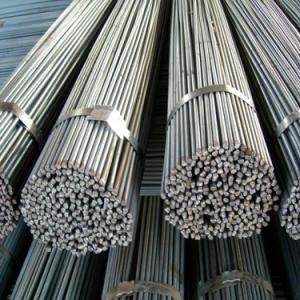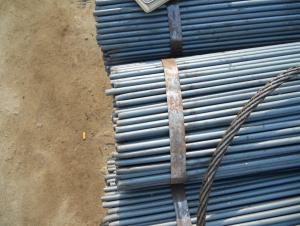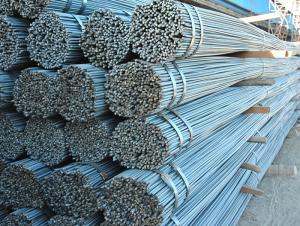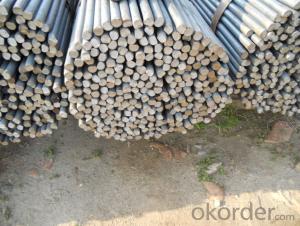Q345 Steel Round Bar
- Loading Port:
- China Main Port
- Payment Terms:
- TT OR LC
- Min Order Qty:
- -
- Supply Capability:
- -
OKorder Service Pledge
OKorder Financial Service
You Might Also Like
Specifications of Steel Round Bar:
1. Standard: GB
2. Grade: Q345
3. Invoicing on theoretical weight or actual weight as customer’s request
4. Shape: Round bar, solid bar of steel with circular section
5. Technique: Hot rolled
Size:
| Size (mm) | Section Area (cm2) | Mass (Kg/m) |
| 50 | 1962.5 | 15.4 |
| 80 | 5024 | 39.5 |
| 100 | 7850 | 61.7 |
Packaging & Delivery of Steel Round Bar:
Packaging Detail: Standard seaworthy packing or as customer required; all goods are packed in bundle with steel strips and shipped by break bulk vessel or container
Delivery Detail: 45 days
Trade terms: FOB, CFR, CIF or as customer required
MOQ: 25 tons per specification; we can negotiate the quantity if the specification is normal or we have stock of one specification.
Weight: The price invoicing on theoretical weight basis or actual weight basis depends on customer’s request.
Shipment: The shipment of bulk break or container is depends on customer’s request.
Documents given: Full set (3/3) of original clean on board bill of lading; Original signed commercial invoice, in 3 originals and 3 copies; Original packing list in 3 originals and 3 copies; Policy of insurance; Certificate of origin and what the target market needs.
* If you would like to get our price, please inform us the size, standard/material and quantity. Thank you very much for your attention.
- Q:How do steel round bars compare to aluminum or steel tubing?
- Each material, steel round bars, aluminum tubing, and steel tubing, possesses distinct properties and applications. Therefore, it is crucial to comprehend the characteristics of each material prior to making a comparison. Steel round bars consist of solid cylindrical bars crafted from steel. Renowned for their strength and durability, they are suitable for heavy-duty applications. These bars exhibit exceptional tensile strength and can withstand significant levels of stress and pressure. Consequently, they find extensive use in construction, manufacturing, and engineering projects where strength and structural integrity are paramount. Moreover, steel round bars exhibit high resistance to corrosion, rendering them appropriate for outdoor and marine applications. In contrast, aluminum tubing is constructed using lightweight and corrosion-resistant aluminum. This material is recognized for its outstanding thermal and electrical conductivity. It is commonly employed in applications where weight reduction is crucial, such as in the aerospace and automotive industries. Additionally, aluminum tubing is frequently utilized in the construction of heat exchangers and electrical wiring systems due to its conductivity properties. Steel tubing, similar to steel round bars, is composed of steel, but it possesses a hollow structure. Known for its versatility and wide range of applications, steel tubing is available in various shapes and sizes, such as round, square, and rectangular, enabling the creation of diverse structural designs. Construction, automotive manufacturing, and industrial applications frequently employ steel tubing due to its high strength and rigidity, which make it suitable for applications necessitating structural support or the ability to endure heavy loads. When comparing the three materials, steel round bars outperform aluminum and steel tubing in terms of strength and durability. Consequently, they are ideal for heavy-duty applications that demand substantial strength and structural integrity. However, steel round bars may be heavier and more costly than aluminum tubing, which is often favored for lightweight applications. Conversely, steel tubing offers versatility in shape and size, permitting greater design options. Ultimately, the selection between steel round bars, aluminum tubing, and steel tubing hinges on the specific requirements of the application, including factors such as strength, weight, cost, and corrosion resistance. It is essential to meticulously evaluate these factors and seek advice from experts to determine the most suitable material for a given project.
- Q:What are the different treatments available for steel round bars?
- Depending on the desired properties and applications, there are several treatment options available for steel round bars. Some commonly used treatments are as follows: 1. Altering the mechanical properties of steel round bars can be achieved through heat treatment. This involves heating the bars to a specific temperature and then cooling them rapidly or slowly. By doing so, hardness, strength, toughness, and resistance to wear and corrosion can be improved. 2. To increase hardness, quenching can be employed. This entails rapidly cooling the heated steel round bars in a liquid medium, such as water or oil. Following quenching, tempering is carried out by reheating the steel to a lower temperature. This reduces brittleness and enhances toughness. 3. Surface hardening is a treatment method used to enhance the hardness of the outer layer of steel round bars while maintaining a tough and ductile core. Common techniques for surface hardening include carburizing, nitriding, and induction hardening. 4. Cold working involves deforming the steel at room temperature through processes like rolling, drawing, or extrusion. This treatment strengthens and increases the hardness of the steel round bars. Additionally, it improves dimensional accuracy and surface finish. 5. To enhance resistance to corrosion and wear, a protective coating can be applied to steel round bars. Zinc plating, galvanizing, and various types of paint or epoxy coatings are commonly used for this purpose. 6. Shot blasting is a treatment technique where small metallic or abrasive particles are shot at high speeds onto the surface of the steel round bars. This process removes contaminants, scale, and rust, resulting in a clean and polished surface. It is important to consider the specific requirements of the steel round bars and the intended application when choosing a treatment method. Consulting with experts or metallurgists is recommended to determine the most suitable treatment for a particular situation.
- Q:What are the advantages of using nickel-chromium-manganese alloy steel round bars?
- Nickel-chromium-manganese alloy steel round bars offer numerous benefits in various applications. Firstly, this type of alloy steel provides exceptional strength and durability. The combination of nickel, chromium, and manganese enhances the overall strength of the steel, making it resistant to wear, impact, and deformation. This is particularly advantageous in industries such as construction, manufacturing, and automotive, where the round bars are commonly used for structural support and load-bearing purposes. Secondly, the round bars made from nickel-chromium-manganese alloy steel exhibit outstanding corrosion resistance. The presence of nickel and chromium in the alloy composition results in high resistance to rust and oxidation, even in harsh environments or exposure to corrosive substances. This property is crucial in applications where the round bars are exposed to moisture, chemicals, or high temperatures, such as marine environments or chemical processing plants. Additionally, this type of alloy steel offers excellent weldability and machinability. The balanced composition of nickel, chromium, and manganese enables easy welding and machining operations. This convenience allows fabricators and manufacturers to work with the round bars, creating complex shapes or structures without compromising the material's integrity. Moreover, nickel-chromium-manganese alloy steel round bars possess exceptional heat resistance. The presence of nickel and chromium in the alloy composition enhances its ability to withstand high temperatures without losing strength or shape. This property makes it suitable for applications involving exposure to extreme heat, such as furnace components, heat exchangers, or high-temperature industrial processes. Lastly, the use of nickel-chromium-manganese alloy steel round bars often leads to long-term cost savings. Due to their remarkable strength and durability, these round bars have a longer lifespan compared to other materials. This reduces the need for frequent replacements, resulting in lower maintenance costs and improved overall efficiency. In conclusion, the advantages of nickel-chromium-manganese alloy steel round bars include remarkable strength and durability, corrosion resistance, weldability, machinability, heat resistance, and long-term cost savings. These properties make them a preferred choice in various industries that require high-performance materials.
- Q:What are the advantages of using nickel-chromium-molybdenum alloy steel round bars?
- There are several advantages of using nickel-chromium-molybdenum alloy steel round bars: 1. High strength and durability: Nickel-chromium-molybdenum alloy steel round bars have excellent mechanical properties, including high tensile strength and hardness. This makes them ideal for applications that require a strong and durable material. 2. Corrosion resistance: The addition of nickel and chromium in the alloy steel composition enhances its resistance to corrosion, making it suitable for use in environments where exposure to harsh chemicals or moisture is a concern. This corrosion resistance extends the lifespan of the round bars and reduces the need for frequent replacements. 3. Heat resistance: Nickel-chromium-molybdenum alloy steel round bars can withstand high temperatures without losing their structural integrity. This makes them suitable for applications that involve exposure to extreme heat, such as in the manufacturing of boilers, heat exchangers, and other heat-resistant equipment. 4. Versatility: The nickel-chromium-molybdenum alloy steel round bars can be easily machined and fabricated, allowing for various shapes and sizes to be produced. This versatility makes them suitable for a wide range of applications in industries such as aerospace, automotive, oil and gas, and construction. 5. Fatigue resistance: The alloy composition of nickel-chromium-molybdenum steel enhances its fatigue resistance, making it suitable for applications subjected to cyclic loading or repeated stress. This property ensures that the round bars can withstand prolonged use without experiencing fatigue failure. 6. Weldability: Nickel-chromium-molybdenum alloy steel round bars have good weldability, allowing for easy joining or fabrication processes. This makes them suitable for applications that require welding or other forms of joining, providing flexibility in design and construction. Overall, the advantages of using nickel-chromium-molybdenum alloy steel round bars make them a preferred choice in various industries where strength, durability, corrosion resistance, heat resistance, versatility, fatigue resistance, and weldability are crucial factors for success.
- Q:Weight algorithm of round steel
- 1, the appearance is different, round steel appearance of round, no grain without ribs, other steel surface appearance has carved or ribbed, this causes the round bar and concrete bonding force is small, and other steel and concrete bonding force.2 ingredients are different, round steel (grade a steel) belongs to ordinary low carbon steel, and other steel bars are mostly alloy steel. 3 strength, steel and other steel with high strength low strength, namely, diameter of the same size as compared with other steel, round steel can bear the pulling force than other reinforced small, but the plastic steel reinforced bar is stronger than the other, there is a large deformation in the break before, and it reinforced the deformation the break before the much smaller.
- Q:Can steel round bars be used for making kitchen utensils?
- Yes, steel round bars can be used for making kitchen utensils. Steel is a strong and durable material that is commonly used in the production of kitchen utensils due to its resistance to corrosion, heat, and chemical damage. Steel round bars can be easily shaped and molded into various utensils such as spoons, forks, knives, and ladles. Additionally, steel utensils are non-reactive, which means they do not leach harmful substances into food, making them a safe choice for cooking and food preparation.
- Q:What are the different types of finishes available for steel round bars?
- Steel round bars offer a variety of finishes, each with its own unique properties and appearance. 1. Mill Finish: The most commonly used finish is the mill finish, where the steel is left in its natural state after rolling and cooling. This results in a rough texture and the possibility of surface imperfections. 2. Hot Rolled Finish: Achieved by heating the steel to high temperatures and shaping it through rolling. This finish provides a smooth surface and is typically used in applications where aesthetics are not a priority. 3. Cold Drawn Finish: Involves pulling the steel through a die to reduce its diameter and increase its length. This finish offers a smooth surface, improved dimensional accuracy, and tighter tolerances. 4. Polished Finish: Steel round bars can be polished to achieve a smooth and reflective surface. This is done using abrasive materials or compounds to remove imperfections and enhance appearance. 5. Ground Finish: A process that involves removing a thin layer of material from the steel surface using abrasive grinding wheels. This creates a smooth and even finish suitable for applications that require precise dimensions and tight tolerances. 6. Coated Finish: Steel round bars can be coated with different materials for added protection against corrosion or to enhance appearance. Common coatings include galvanization, which applies a layer of zinc, and powder coating, which provides durability and a decorative finish. When choosing a finish for a steel round bar, it is important to consider the specific application and desired properties. Factors such as corrosion resistance, aesthetics, dimensional accuracy, and surface quality should be taken into account.
- Q:What are the advantages of using chromium-vanadium alloy steel round bars?
- Some advantages of using chromium-vanadium alloy steel round bars include: 1. High strength and toughness: Chromium-vanadium alloy steel has excellent strength and toughness properties, making it suitable for applications requiring durability and resistance to wear and tear. 2. Improved corrosion resistance: The addition of chromium enhances the alloy's corrosion resistance, making it resistant to rust and other forms of corrosion, even in harsh environments. 3. Enhanced hardenability: Chromium-vanadium alloy steel can be easily heat-treated to achieve high hardness levels, allowing for increased wear resistance and improved overall performance. 4. Good machinability: The alloy steel round bars can be easily machined and fabricated, making them convenient to work with in various manufacturing processes. 5. Cost-effective: Chromium-vanadium alloy steel offers a good balance between performance and cost, making it a cost-effective choice for many applications compared to other high-performance alloys.
- Q:What is the thermal conductivity of a steel round bar?
- The thermal conductivity of a steel round bar can vary depending on the specific type of steel and its composition. Generally, carbon steel has a thermal conductivity ranging from 26 to 48 watts per meter-kelvin (W/m·K), while stainless steel typically has a slightly lower thermal conductivity of 15 to 27 W/m·K. However, these values are approximate and can vary based on factors such as temperature, impurities, and alloying elements. It is important to note that thermal conductivity is a property that describes the material's ability to conduct heat and is usually measured in units of W/m·K.
- Q:Can steel round bars be polished?
- Indeed, it is possible to polish steel round bars. The act of polishing steel round bars encompasses the utilization of abrasive substances, for instance, sandpaper or polishing compounds, to eliminate any flaws or coarse areas on the bar's exterior. This procedure can be executed manually or with the aid of machinery exclusively devised for polishing metals. Ultimately, a sleek and lustrous surface is achieved on the steel round bar. Nevertheless, it is imperative to acknowledge that the specific polishing methods and materials needed are contingent upon the type of steel and the desired end result.
1. Manufacturer Overview |
|
|---|---|
| Location | |
| Year Established | |
| Annual Output Value | |
| Main Markets | |
| Company Certifications | |
2. Manufacturer Certificates |
|
|---|---|
| a) Certification Name | |
| Range | |
| Reference | |
| Validity Period | |
3. Manufacturer Capability |
|
|---|---|
| a)Trade Capacity | |
| Nearest Port | |
| Export Percentage | |
| No.of Employees in Trade Department | |
| Language Spoken: | |
| b)Factory Information | |
| Factory Size: | |
| No. of Production Lines | |
| Contract Manufacturing | |
| Product Price Range | |
Send your message to us
Q345 Steel Round Bar
- Loading Port:
- China Main Port
- Payment Terms:
- TT OR LC
- Min Order Qty:
- -
- Supply Capability:
- -
OKorder Service Pledge
OKorder Financial Service
Similar products
New products
Hot products
Related keywords































